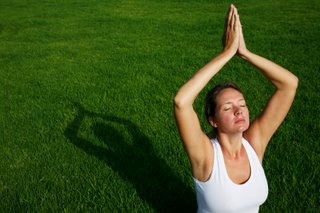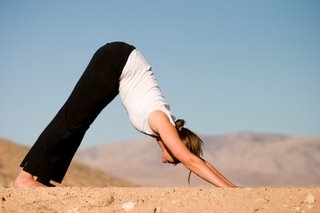|
 Secure Site
Secure Site
|
 |
Archive for September, 2010
 entering silence, starry night in the wilderness How one woman survived three days in the wilderness—alone.
I shivered in the pitch-black night as a steady rain showered my head. I sank deeper into a state of abject loneliness with every miserable drop. My saturated sleeping bag weighed me down as I searched blindly for my flashlight, all the while berating myself for not tying up the tarp before I fell asleep beneath a formerly clear, starry night.
Feeling panicky on the first night of my solo experience in the woods, I imagined the worst—three days of rainy, damp desolation. What am I doing here? I wondered. I could be home, snuggled up with my husband in our cozy bed!
And then it hit me. I realized that this moment was exactly why I had come here—to face my demons head-on, to ride out the fear of being alone in the dark and of being eaten, possibly, by a bear. Isn’t that what a vision quest is all about? Flinging oneself into the wilderness (in this case, a California state park on Labor Day weekend, but still) to test one’s inner strength and hopefully receive some sort of life guidance, perspective, and inspiration?
For the last 10 years, I had contemplated embarking on a quest like this with awe and trepidation. An extrovert by nature, I thrive on the company of others. I can’t be alone in my own house for five minutes without feeling anxious, so how could I endure three entire days by myself? I feared I would go crazy with no one to talk to, engulfed by the deafening silence of nature.
To my surprise, I discovered that nature is extremely loud. Have you ever heard throngs of blue jays chattering overhead at the crack of dawn? I was definitely not alone—from the disturbed gopher under my sleeping bag (was I camped on his house?) to the constant parade of insects, birds, and critters, I was in a forest teaming with life and endless entertainment.
Two days later as I packed my gear, I had a hard time believing the time had passed so quickly. Suddenly the power of facing and overcoming my deepest fears overwhelmed me, and I fell to my knees sobbing. A strength I never knew existed inside me welled up as I realized I could now be alone and unafraid.
I shouldered my backpack, danced a little jig to celebrate my emancipation, and walked out of the wilderness a changed woman.
adapted from Natural Solutions Magazine, Sept. 2009 by Laura Gates
 Zen Alarm Clock, a natural chime sound alarm clock
Now & Zen
1638 Pearl Street
Boulder, CO 80302
(800) 779-6383
Posted in Bamboo Chime Clocks, Chime Alarm Clocks, Hokusai Wave, intention, Natural Awakening, Now & Zen Alarm Clocks, Progressive Awakening, sleep, Well-being
 meditation in motion, walking mindfulness practice Attention, multitaskers: Want to exercise and meditate at the same time? Try Breathwalk, a form of walking meditation that incorporates pranayama and mantra techniques from the Kundalini Yoga tradition. The late Yogi Bhajan introduced this practice to the West in the early 1970s. Since then, yoga students of all shapes and sizes have used it to improve their cardiovascular health, tone their nervous system, boost their energy, stabilize their moods, quiet mental chatter, and embrace the present moment. In its full form, Breathwalk is a five-step process that can take up to 60 minutes; here’s an abbreviated routine you can do in less than 20. Try it in a meadow, on the beach, in the woods, or, if you’re feeling adventurous, on a city street.
The Practice
Begin walking at a normal pace, observing your bodily sensations. Then tune into your breath. Are you breathing with your chest muscles or with your diaphragm? Is your breath shallow and erratic or smooth and deep? Noisy or quiet? Through your mouth or through your nostrils? Gradually refine your breath so that it becomes nasal, diaphragmatic, and free of noise and irregularities.
Now coordinate your breath with your stride, inhaling for four steps and exhaling for four steps. When this feels comfortable and automatic, begin to practice the following breathing pattern: Keeping your nasal passages and facial muscles relaxed, take four short staccato puffs of air through the nostrils—one puff for each step. (Your breath will be audible now; focus on the sound.) Essentially, you are dividing your inhalation into four segments that are synchronized with four consecutive steps. After the first puff, your lungs should be about one-quarter full; after the second, two-quarters full; after the third, three-quarters full; and after the fourth, four-quarters full.
 zen stones Without pausing, exhale in the same fashion, contracting the abdominal muscles and pushing the navel to the spine for four steps (and four segments of the out-breath), so that the final puff pushes the last quarter of air out of your lungs. Continue this pattern for five minutes, then walk and breathe normally for three minutes. As Gurucharan Singh Khalsa, senior student of Yogi Bhajan and co-author of Breathwalk, says, “It’s not about, ‘How far did I walk, how many calories did I burn, how much effort was expended?’ It’s about synchronizing the body, breath, and mind to the present moment, about experiencing a profound sense of connection with yourself and nature.”
Now, repeat the eight-minute practice. This time, as you synchronize your segmented breath with your stride, mentally say the mantra sa ta na ma—one sound for each step and each segmented breath. Repeat the mantra in coordination with the quartered breath for five minutes, then walk and breathe normally for another three.
“Practice for three days in a row and you’ll feel the energizing, focusing effects immediately,” Khalsa says. “If you do it for 40 days you can get really intimate with the technique. You can slip it into the cracks of your day to support you—that’s its purpose.”
adapted from Yoga International, by Shannon Sexton
 Tibetan Meditation Timer with Brass Singing Bowl Now & Zen
1638 Pearl Street
Boulder, CO 80302
(800) 779-6383
Posted in Bamboo Chime Clocks, Meditation Timers, Meditation Tools, mindfulness practice, Now & Zen Alarm Clocks, Zen Timepiece by Now & Zen, Zen Timers
 Lake Meditation Lake Meditation
Move your attention from the mountain to the lake. Crystal-clear, turquoise-hued lakes toward the peak of some mountains in the Himalayas are called “sky lakes” because they so perfectly reflect the sky above. Protected by the higher peaks and trees, the surface of such a lake is smooth and calm. You don’t need to visualize yourself as a lake. Rather, contemplate the lake and its quality of reflectivity. Notice how the water is translucent, allowing you to see into its depths. Notice how it is also as reflective as a mirror, so you can see your face and the sky above on its surface. As you imagine yourself looking into the surface of the water, notice how the water reflects only what is there, neither editing out nor adding in anything. The water reflects the dark, ominous storm clouds and the fluffy white clouds equally. When birds fly overhead, the water reflects them; yet once they are gone from the sky, it shows no trace of them.
When the waves (vritti) are calmed, the mind (citta) has this dual ability of the lake to be both translucent and reflective. Once your mind is stabilized, you can turn your attention to it. Imagining your mind to be as translucent and reflective as the sky lake may bring forth thoughts, feelings, and emotions, but you can simply reflect what arises without judging or comparing, and without editing out anything through aversion or denial. Perceptions of sound, smell, or touch may arise, and, free of grasping and pushing away, you can simply reflect. In this way, destructive or unwholesome patterns can be seen, so that their power over you is lessened. Attachments are loosened. Breathing in, see yourself as the water of the sky lake; breathing out, reflect.
adapted from Yoga Journal, by Frank Jude Boccio
 Zen Chime Alarm Clock and Timer Now & Zen
1638 Pearl Street
Boulder, CO 80302
(800) 779-6383
Posted in Bamboo Chime Clocks, intention, Meditation Timers, Meditation Tools, mindfulness practice, Now & Zen Alarm Clocks
 Yoga Corpse Pose Corpse Pose Meditation
This restful pose, called savasana in Sanskrit, provides a calming and centering ending to your yoga practice. This is when you allow all that you’ve just done to “soak in.” Set your Zen Meditation Timer to 15 minutes. Spend at least 10 to 15 minutes in corpse pose, lying on your back with your palms facing up. Use this meditation on the four elements to focus the mind and body.
Earth: Sense the earth supporting you and absorbing all unnecessary tension. Feel yourself being cradled by the ground beneath you, relaxed and breathing deeply.
Wind: Feel yourself being bathed by the wind, carrying your prayers and intentions on its wings while blowing away any nagging thoughts that come to mind.
Fire: Visualize a ring of fire surrounding you from a safe distance, protecting you from any threatening external forces and sealing in the energy from your practice. Picture yourself casting all unwanted tension and worry into the flames of that fire.
Water: Imagine a gentle rain cooling and purifying you, washing away all fears and anxiety, relaxing and refreshing you. Feel yourself floating in warm water, totally protected and balanced.
Four Elements: Visualize each of these four elements moving through you from the tips of your toes to your crown and back again. See this as a beautiful, spiritual, energizing flow of energy. Feel it balancing all of your internal systems and boosting your immune system in positive, healthy ways.
adapted from Wholeliving Magzine, July/August 2005 by Terri Trespicio
 Digital Zen Alarm Clock, a meditation timer and progressive alarm clock
Now & Zen
1638 Pearl Street
Boulder, CO 80302
(800) 779-6383
Posted in yoga, Yoga Timer, Yoga Timers by Now & Zen
 yoga pose - water exercise Life-Giving, Calming
Water is vital, soothing and rejuvenating to our bodies and senses, and it’s the flow of water that inspires the easy, smooth flow of yoga practice. While doing yoga near a body of water can be very nourishing for the soul — its relaxing sounds, the cooling, calming energy it exudes — you don’t need to be near water to experience its effects. You can focus on the qualities of water and think of your own breath as flowing in and out of you like the tides, refreshing and nurturing every cell.
Water Exercise
This exercise is inspired by tai chi and includes both fluid movement and balance while standing in place.
1. Stand with heels together, toes apart.
2. Keeping your knees soft, rock back and forth to find perfect center balance.
3. With hands together in prayer position, reach up over your head through the air. Open your arms as if you’re doing a breaststroke, and push the air away as if it were water. Sweep your arms out and down, returning them to your sides. Inhale as you swim “out,” rise up on your toes, and exhale as you gently bring your hands back and lower onto your feet.
4. Repeat the motions at least 10 times, gradually working up to 20.
To Experience Water
Practice near a body of water — the ocean, a lake, or a swimming pool. Find a waterfall or fountain. Try practicing in the morning or evening to feel and see the dew on the grass and leaves. Practice meditation.
adapted from Wholeliving Nagazine, July/August 2005 by Terri Trespicio
 Digital Yoga and Meditation Chime Timer in Solid Walnut Now & Zen
1638 Pearl Street
Boulder, CO 80302
(800) 779-6383
Posted in yoga, Yoga Timer, Yoga Timers by Now & Zen
 yoga downward facing dog pose Strength, Power
Fire is protective, purifying, and energizing. You can feel the power of fire from the sun, stars, and moon — whether you can see them or not. This kind of cosmic energy radiates through us on a sunny or overcast day, at dawn or dusk. Throughout your practice, as you draw energy from the earth and power from the wind, feel that influx of solar energy nurturing and purifying your mind, body, and soul. One way to nurture this energy is to feed your inner fire with a challenging, energy-building pose.
Fire Exercise
1. From Mountain pose move into Chair pose by first raising your arms so they are perpendicular to the floor and in line with the back and neck. Bend your knees and lower your tailbone as if you are sitting, lowering until your thighs are almost parallel to the ground. Keep your knees aligned with your ankles, and hold for five breaths.
2. Straighten legs and dive into a forward fold as you exhale, then step back into Downward-Facing Dog, hands and feet on the ground, hips raised, heels pressing toward the ground, arms firm, fingers spread, and palms flat. Hold for a few breaths to build heat in the body.
3. Exhale as you pull your left knee in toward your forehead and hold, engaging your core.
Return left leg to Downward Dog and repeat with the right leg. Jump or step your feet into forward fold; slowly roll up.
To Experience Fire
Feel the sun’s warmth on your body. Bathe in cool moonlight and starlight, which are reflected from the sun. Watch for fireflies after sundown. Practice by candlelight.
adapted from WholeLiving Magazine, July/August 2005 by Terri Trespicio
 Digital Zen Alarm Clocks and Timers for Yoga and Meditation with Chimes
Now & Zen
1638 Pearl Street
Boulder, CO 80302
(800) 779-6383
Posted in yoga, Yoga Timer, Yoga Timers by Now & Zen
 Yoga Wind Exercise Freedom, Breath
The wind is a nurturing influence — it gives us our breath, and, according to ancient Tibetan lore, carries our prayers around the world on “wind horses” to where they’re needed. Wind is also a great connecting force. It cannot be contained; it’s the definition of freedom. Wind can introduce the element of surprise in your outdoor practice — like a dance partner, you need to respond to it.
This exercise, paired with gentle breathing, releases tension in the muscles while helping you perfect your balance and strengthen your spine. Imagine yourself caressed, lightened, and strengthened by the wind.
Wind Exercise
1. Stand in Mountain pose with a slightly widened stance and feet firmly on the ground.
2. Begin a spinal rotation, starting at the waist and gently turning the upper body, face, shoulders, arms, and hands from side to side. Rotate the spine like a washing machine, allowing the muscles to release and the arms to flop loosely, patting the body with each turn. Let the movement flow back and forth.
3. Breathe in for one complete rotation, then out for a rotation; keep this rhythm going for at least 20 rotations.
4. Return to center. Bring your heels together with toes slightly apart, and let your arms relax at your sides.
To Experience the Wind
Choose a spot on higher ground or in a clearing. Become aware of the air around you, its subtle movement over your skin. Feel the air with all of your senses — smell it, taste it, touch it, and hear it.
Imagine you are the wind and can move effortlessly.
adapted from Wholeliving Magazine, July/August 2005
 bamboo meditation timer and natural alarm clock
Now & Zen
1638 Pearl Street
Boulder, CO 80302
(800) 779-6383
Posted in yoga, Yoga Timer, Yoga Timers by Now & Zen
|
|
|
|